You have made the decision to hike the Camino de Santiago Camino Frances – what next? I bet you have a bunch of questions you need answered such as where to stay, what to eat, what to bring, and how to find your way.
You can get all of your basic questions about walking the Camino de Santiago answered right here! If you have questions about hiking the Camino Frances, that I didn’t cover – please leave them in the comments and I will add them to this list periodically.
Table of Contents
My Experience Walking the Camino de Santiago
I walked from Pamplona to Santiago in 2012, and I knew absolutely nothing about what I was about to take on when I walked out of my hotel in Pamplona and onto the Way of Saint James. I don’t recommend taking something like this on so blindly as I did…but it is possible.
It took me 5 weeks to complete the walk including a rest day every week. I strongly encourage a rest day once a week, it’s just enough for your body and feet to rejuvenate. Plus – it meant that I met a new group of people each week too which was nice.
Weekly Camino de Santiago Blog from a Beginner
On that rest day, I wrote a blog post about my previous week’s experiences and what I learned each week. If you want to see how I evolved throughout the pilgrimage check out these posts:
Starting Out in Pamplona
Week 1 – Santa Domingo Spain
Week – 2 – Carrion de los Condes Spain
Week – 3 – Astorga Spain
Week 4 – Sarria Spain
Week 5 – Santiago Spain
23 of the Most Frequently Asked Questions about the Camino de Santiago
As I walked, I thought of all of the questions I had when I started, and here were the ones that were the most burning. Hopefully, they’ll help you plan your way and understand what you are taking on – unlike me!
1. Do you need a guidebook?
You really don’t need a book or guide to walk the Camino de Santiago (I didn’t use one) with my list of FAQs, however, if you want one – A Pilgrim’s Guide to the Camino de Santiago: St. Jean – Roncesvalles – Santiago (Camino Guides) is the one I saw most people carrying on the trail. But here’s a few good ones that can help plan overall:
Camino de Santiago Guides That Can Help You Plan or Inspire Your Trip
2. Where do you sleep?
There are many choices and you do not have to carry camping gear unless you choose to sleep outside.
Albergues are the cheapest option ranging from 4 to 10 Euro a night for a dorm bed. There are municipal ones and private ones where the private albergues normally have a bit nicer conditions. You can be in a room of 10 people or 60 – you never know what to expect. Everyone shares a bathroom/shower and there is normally a kitchen for you to use. Once you get used to sleeping with a crowd, they aren’t bad and you can’t beat the price.
In most villages, there are also options to stay in more traditional ‘hotel’ rooms with private baths such as a pension, a hostel, a casa rural, or a high-end hotel or historical building. Basically, a hostel and pension are the same – a budget hotel room (some have shared bathrooms) which is normally privately owned and small. A hotel is owned by a larger business and operates on the 5-star system which also means they are a bit more expensive. A posada is normally a historical building that has been refurbished like the one I stayed at in Astorga called Casa de Tepa.
3. Is it physically hard to do?
Not really. There are certainly hard times, and you can be caught in the elements – but this is not a technical hike, it’s more about endurance than it is about physical strenuous demands. However, endurance is not easy and to get up and walk (no matter how flat the trail is) every day – day after day for 5 weeks does take its toll on your feet and back. Most days I woke up very sore.
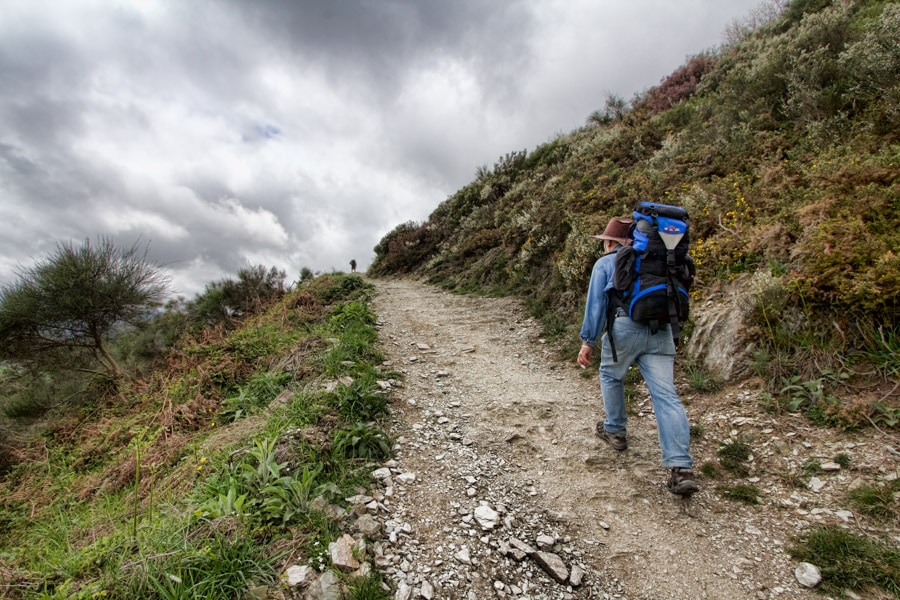
4. Do you need to know Spanish?
I did not know any Spanish when I started, however, I was able to learn a few key vocabulary words for food and how to reserve a bed. Surprisingly most shopkeepers and albergue owners did not speak much English at all. But through the few words I knew I was able to get by. Plus, everyone on the trail speaks English and you can normally find someone to translate for you if you really find yourself in a bind. It was never really an issue.
And if you don’t have it – for goodness sake, put the Google Translate app on your phone…it’s a lifesaver!
5. What/Where did you eat?
There is ample food along the way with grocery stores if you want to cook yourself or restaurants. Most little shops along the route will also have fruit and bread that you can easily buy each day instead of packing a lot and carrying it. As you walk into different regions you will find different specialties of the area.
Camino Breakfast
Most albergues offer a breakfast for around 3 Euros – this consists of toast with jam and coffee. That’s it. You can also stop at any bar in the village and always get coffee and you’ll normally find croissants or other simple baked goods there.
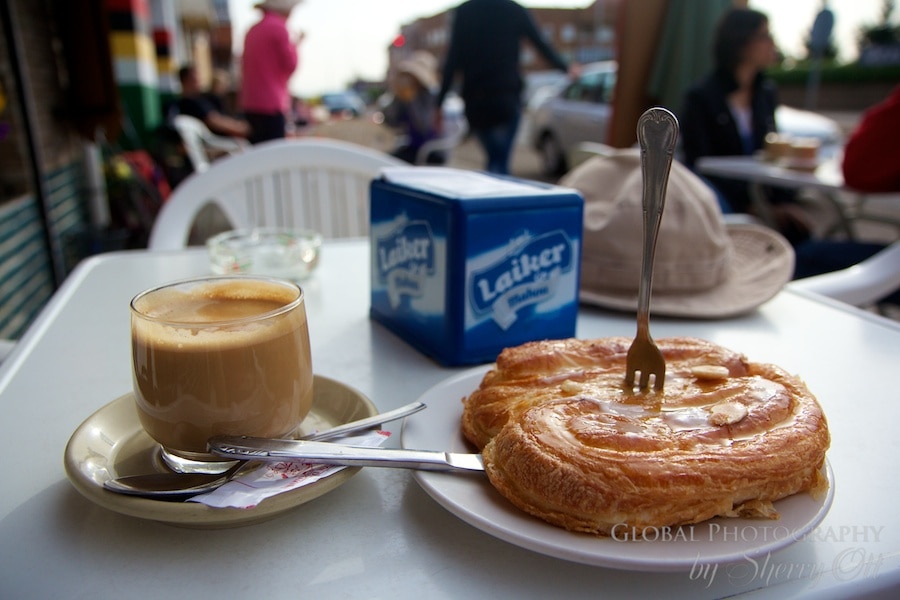
Note—-A ‘Bar’ in Spain is like a café. Yes, there is alcohol there, but they also have coffee and food normally. It’s where the Spanish go to have a snack.
Camino Lunch
You can stop at grocery stores and carry snacks with you – my favorite was nuts, tuna from a can, some bread, and fruit. Or you can stop at a restaurant in a village and have a big ‘Spanish’ lunch with 3 courses and wine.
Camino Dinner – aka Pilgrim’s Menu
Every village where there are albergues or lodging options has a Pilgrim Menu for 7 to 10 Euros. The menu is a choice of starter (salad, spaghetti, etc), a main course (meat/fish and fries), and a dessert (flan, piece of fruit) – plus very generous portions of wine throughout the meal. These Pilgrim Menus are normally very simple and the food is normally just food to fuel.
There were a few places that stood out to me that really put out good quality food, but most of the food was quite basic and after 5 weeks of it I was quite tired of it! My favorite by far was the Italian restaurant in Saria called Matias Locanda Italiana – homemade pasta!
6. Did you cook your own meals?
No, but I could have if I wanted. Many people got groceries and made meals at the albergues. If they were solo travelers they would generally bond together with others and a group of people would split the cost and cook.
7. What hiking gear do you need?
Here are some quick things to think about bringing:
Backpack – A good pack with a waist band that transfers all of the weight to your hips instead of your shoulders. This is the most important decision you’ll make.
Discover the essential hiking gear to pack for any hike
Vari-Slide System allowing exact adjustment to every back length, ensuring the pack sits perfectly on your hips. A comfortable women's backpack for longer hiking trips that can go from 45L to a max of 55L.
Hiking poles are optional – but many use them. It really does help with uneven surfaces. Many of our landings included hikes on pretty rocky/boulder-covered ground. It was nice to have a little extra balance.
One Pair (2 Poles) - Ultra Light, Quick Locking, and Ultra Durable
Wool Socks – I prefer these as they dry overnight and they don’t hold odor! You really only need a couple of pairs. You can get different weights and even use wool in the summer. Or you can also try wool
The cozy merino wool cushioning next to the skin insulates the foot from hot spots. Now featuring 37.5 Technology to keep you dry in the office or on the mountain.
Compression socks are great for faster muscle recovery and to fight blood clots on long flights or long road trips.
PLUS - use discount code OTT15 for 15% off orders!
Dry fit everything – in order to do laundry and get things dry overnight (because you don’t want to carry many clothes at all!), you need to bring dry fit or quick dry clothing.
Clothespins or a travel laundry line that doesn’t need clothespins
Floppy Hat – or hat with a big enough brim that it will also cover the back of your neck. Or maybe this cool Camino de Santiago baseball hat!
Sandals – Comfortable sandals for the albergues but they should also be ones that you could walk in if your boots/shoes are bothering you at times.
See my Complete Camino de Santiago Packing List
Boots vs. Tennis shoes, rain gear needs (don’t forget your camera protection!), laundry supplies, the best ear plugs, and more. Before you go, make sure you have all of these items on my Camino de Santiago packing list!
8. Can you walk the Camino de Santiago in tennis shoes?
Yes, you can – I did the whole thing in trail running shoes. However, there are days when the weather is bad and tennis shoes can be frustrating. When it rained I had a lot of issues in keeping my feet dry and wished I had hiking boots, however, most days – I was pretty happy with my lightweight trail runners. Personal preference – but know that the level of hiking is not hard core – most of the time you are on even surfaces and you aren’t crossing rivers and hiking boots are quite frankly overkill.
9. How much does it cost to do the pilgrimage?
I met people who were doing the walk on as little as 15 to 20 Euros a day for lodging and food – they were cooking their own meals in the albergues.
However on average – I would say if you stay in albergues most days with a pension/hostel one day a week and eat one pilgrim menu a day you can easily stick to a budget of 30 Euro per day. Of course, if you want to do nicer lodging, it’s always possible to spend more.
The breakdown of costs is albergue lodging – 4 to 12 Euros
Food – 15 to 17 Euro a day if you eat a breakfast and pilgrim meal and maybe a snack
The rest is all extra.
Do note that I spent quite a bit on pharmacy shopping! So – be prepared for incidentals.
10. Do you need to plan/reserve in advance for lodging?
No plan is necessary at all – that’s the beauty of it. Each day you can walk to where you want to stop and if you are staying in albergues and are not overly picky about where you sleep, then you can find a place to sleep when you get tired of walking – no reservations necessary. However, most days I would make a plan for that day and then call ahead and tell them I wanted a bed – it wasn’t necessary, but since my larger backpack was being transported I needed to tell them where to leave the bag so it made me do daily planning.
Do note – if you are walking in the summer months – June through August – the trail will be much busier, and space may be filled on some days. So – doing some planning and reserving ahead may be necessary. Check the Camino forums to get advice there.
If you do like to have a plan and know where you are sleeping every night – then that option is fine too. If you want to leave some of the days up to chance and have some days planned – they can help you with that. I personally enjoyed staying in albergues, but about every 4th night, I checked myself into a hotel just for my sleeping and privacy sanity. Rayo could help you organize such an itinerary if you’d like.
11. Can you have your bag transported each day?
Yes – there are a variety of options for this. I used JacoTrans which is the only company that transports along the COMPLETE route of Camino Frances when I did it in 2012. It was worth it to me to work with one company for the complete time.
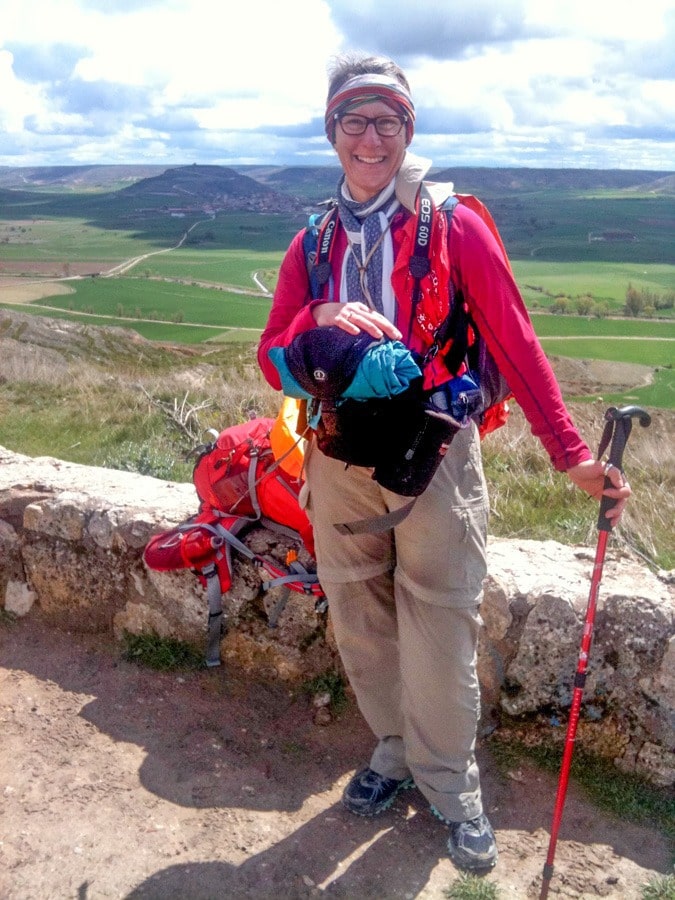
It costs 7 Euro a day to transport the bag. You simply called them the night before and told them where you were and where you were going. Then each albergue/hostel has a JacoTrans envelope that you attach to your bag with this delivery information and put 7 Euro in the envelope. When you arrive at your destination the next day – there’s your bag. You can do this on a daily basis whenever you want to lighten your load – many people did it when climbing over the high passes.
If the walk is part of a bigger trip and you don’t need everything in your pack, You can also transport your bag or items from the beginning directly to Santiago to be stored until you arrive. Here’s a good forum conversation about a few options for transporting luggage to Santiago.
12. What do you carry each day?
A general rule of thumb was that your pack should be no more than 10% of your body weight. Since I had my bigger bag transported daily by JacoTrans, I had to decide what I would carry with me each day in my day pack. Here’s what I carried:
- 2 pairs of extra socks (you always want dry socks)
- Sandals
- First aid kit
- Water
- Buff
- Mittens
- Poncho
- Backpack rain cover
- Pullover/Jumper
- Sunscreen
- Camera/Phone
- Backup drive (yes, I know this is unique to me, but my laptop was being transported daily, so I wanted my backup drive with me)
- Sunglasses
- Headlamp
- Plastic ziplock bags (these are like gold – you never know when you will need them)
- Snacks (fruit, trail mix, bars, tuna, etc)
13. How do you do laundry?
Hostels and Pensions will normally do laundry for you for around 5 to 7 Euros for a load.
Albergues all have washing machines for a couple of Euros and then you can hang your clothes out to dry. Some have drying machines too.
The sink. Many times I washed things out in the sink with some shampoo and then hung to dry overnight.
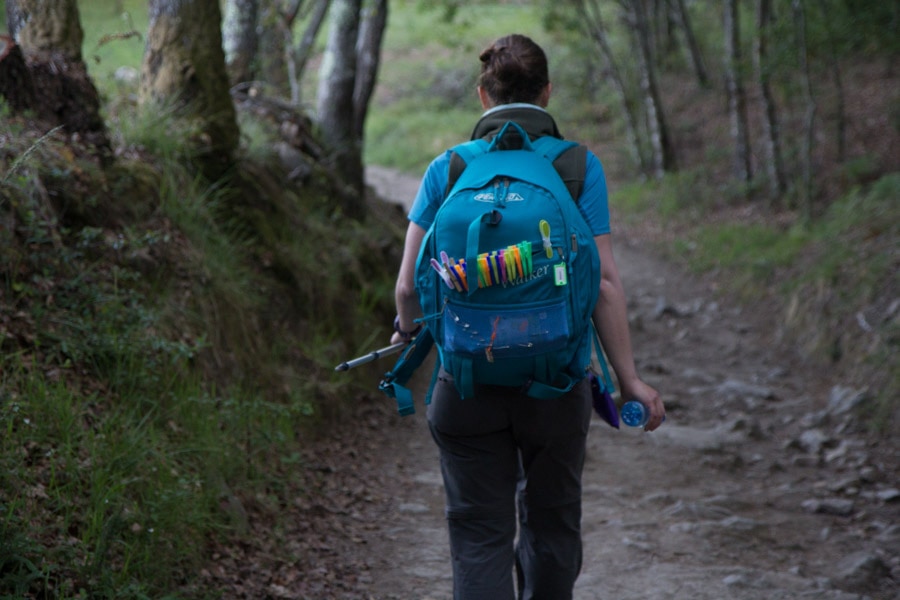
The less you carry (and trust me, you want to carry as little as possible), then the more you have to do laundry. Most people would arrive at their albergues around 2 or 3 PM and the first thing they did was laundry so that they could get their socks and clothes dried so they could wear them again the next day.
14. Where do you go to the bathroom on the trail?
There are plenty of bars, restaurants, and stores along the way that you can use their facilities. However, do try to purchase something at those places if you are using their toilet – Spain needs the business…trust me.
However, you can go to the bathroom on the trail anywhere you feel comfortable – behind a bush, in a field, or behind a building. If you are using toilet paper – it’s a good idea to have a plastic bag where you can store it and throw it away properly. If doing #2, then bury it. Be kind, be smart.
15. Is there internet access along the Camino de Santiago?
Many of the private albergues offer wifi – as well as most lodging in bigger cities. The municipal albergues rarely offered WiFi – however, I expect that has changed since 2012! However, most albergues did have a computer in which you could pay to get on the internet in some way shape, or form.
I also carried an unlocked iPhone and bought a Spanish SIM card that had a data plan that allowed me to check my email and upload phone photos to Facebook and Twitter. I had coverage for this about 75% of the time.
16. Can I walk the Camino de Santiago solo?
YES! I was quite surprised by how many solo walkers there were. Maybe it’s the pilgrimage that lends itself to solo reflection – I’m not sure. You will only be ‘alone’ if you want to be. You don’t have to socialize with anyone if you don’t want to. However, if you want to do this alone and are nervous that you won’t have people to hang out with…don’t worry – there will be plenty of people you will meet and be able to walk with. I generally walked alone most of the day and socialized at night.
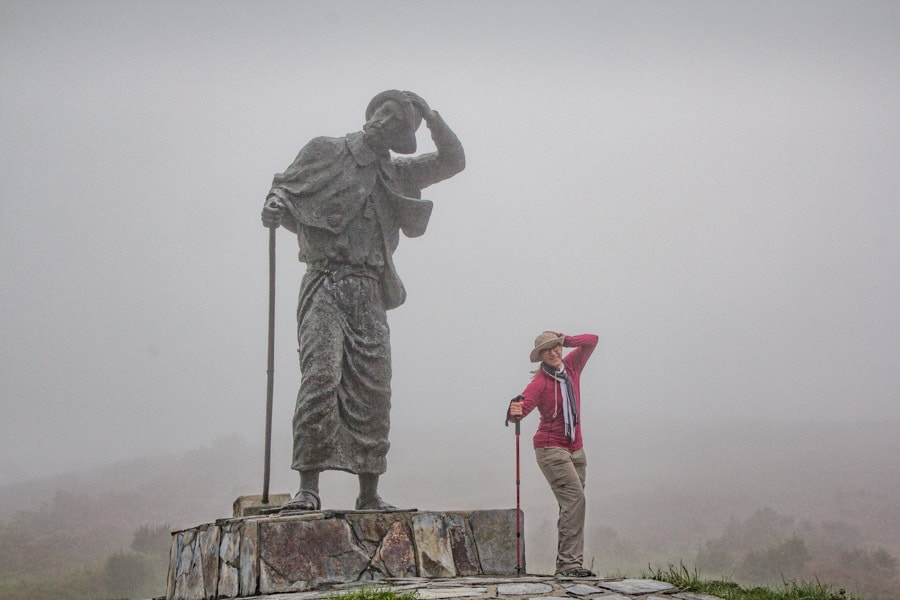
Why You Shouldn’t be Afraid to Walk the Camino de Santiago Solo
If you are at all afraid or concerned about doing the route solo, then read this article about why I think everyone should walk the Camino de Santiago solo. It should dispel your fears and get you on the trail!
Don’t let being solo stop you from this walk!
17. I have limited time to plan, can someone just book everything for me?
Absolutely – people are always happy to do that for a price! I did my hike with Rayo Travel, they booked my entire walk at an average budget. Sadly I believe they are no longer in business though as of 2021.
What I loved about Rayo is that they had people in Spain who live there and are fluent in Spanish and English who can help you with anything along the way. It was crucial to me to have a ‘team’ of people who could speak the language and understand the culture to help me through any difficult situations.
Companies that Do Tours Along the Camino de Santiago
Here are a few other options for companies to utilize for booking portions or all of the Camino de Santiago walk:
Check out Explore Worldwide for Camino de Santiago group trips where you don’t have to do any planning. They run regular trips from Leon to Santiago which might fit better into people’s available vacation time if you don’t have 5 weeks to walk the entire thing.
Marly Camino also offers guided, self-guided, and customized Camino de Santiago Experiences.
18. Is the Camino trail well marked?
YES! There are yellow arrows and scallop shells everywhere. The ‘markers’ are sometimes signs, arrows, spray paint, scallop shells, sidewalk designs, and even flowers. You don’t even need a map at all, just follow all of the markers (some official and some that people just added along the way).
19. Do you have to do the whole thing at once?
No, many people just come and do a week or two at a time and then revisit it again in a year starting where they left off. This is really easy to do if you make your starting and ending points larger cities as the transportation options to/from the cities are greater.
20. What if you get sick or hurt?
Then you simply don’t walk that day if you don’t feel like it. Or you can take a bus or taxi to the next point if you have to keep on a strict schedule. There are plenty of options and no one says that you have to walk the whole thing, many people take buses in/out of large cities as they don’t like walking through the industrial area.
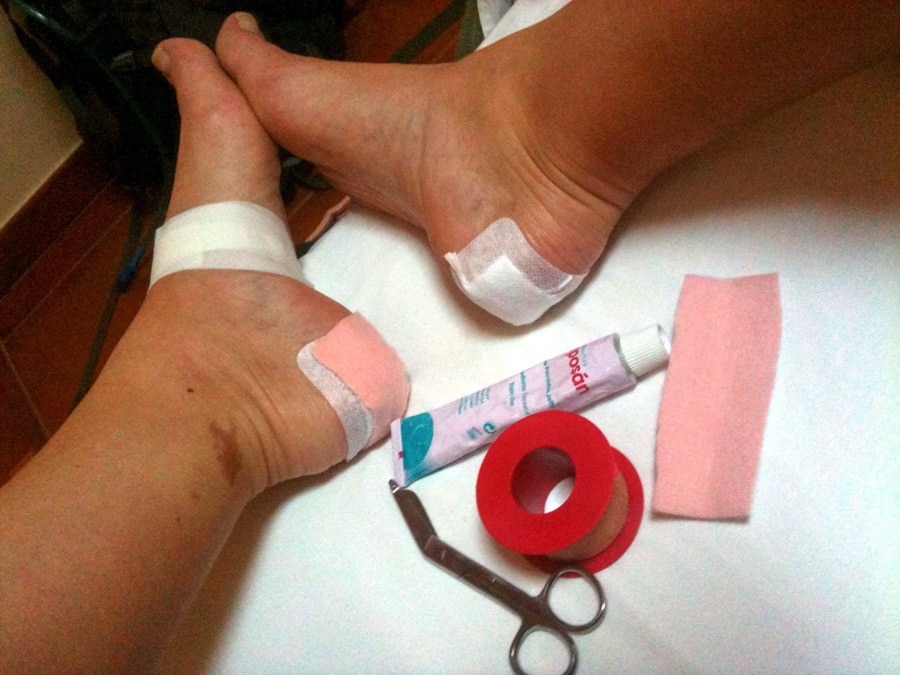
If you fall ill or need to see a doctor – you can take a bus or taxi to get to the nearest city with medical facilities – they aren’t far away.
Like any trip, you should always consider getting good travel insurance in case you have a medical emergency or a large trip delay or interruption. I recommend and use Allianz Travel Insurance, they have a great phone app too that will provide you with information on nearby hospitals.
21. Can you charge your electronics?
Yes – all of the albergues have electric plugs – but they are a hot commodity since more and more people are traveling with phones and other contraptions. The newer and private albergues have designed this with the need in mind and many have plugs right by the bunk bed.
As you stop for lunch or breaks at bars you can also ask the owners to charge your phone behind the bar – or look for a plug that you can use.
Bring an adapter with you for European plugs.
22. Is theft a problem in Albergues?
I didn’t encounter any, however I’m sure it does exist. In the more rural areas, I was a bit more lax with leaving my electronics out of my camera on my bunk bed. However, in bigger cities or towns I always locked my camera and phone up or took it with me. Generally- things left out are pretty safe though as you are on a pilgrimage after all and everyone is sort of in the same boat and you all watch out for each other. But having said that – don’t take unnecessary risks and trust your gut.
23. Do you have to be religious to walk the Camino de Santiago or get anything out of it?
Absolutely not! People walk it for many different reasons – and if you are not religious or Catholic, it’s not a problem.
Want to see what the Camino Frances trail looks like…then check out my Camino de Santiago Photography. Or check out my Camino de Santiago Pinterest board.






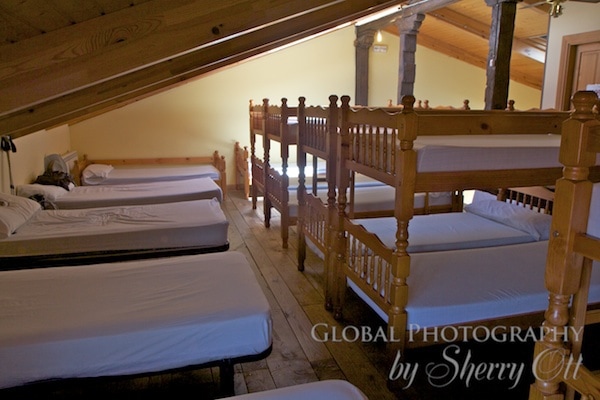

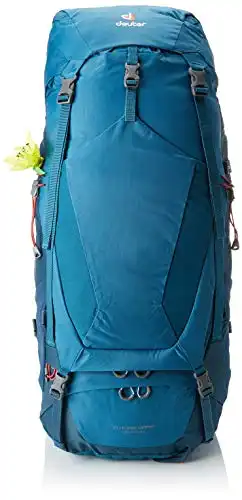
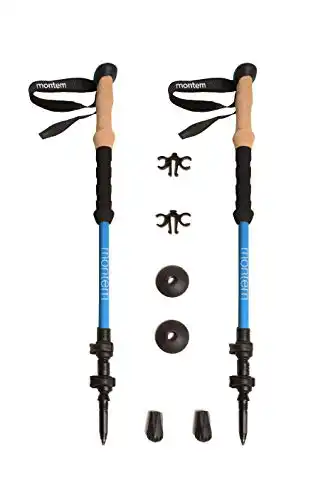
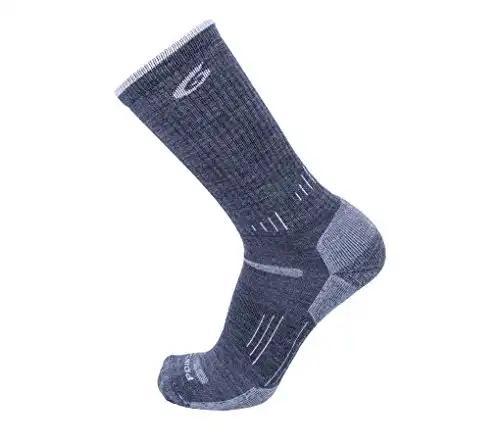
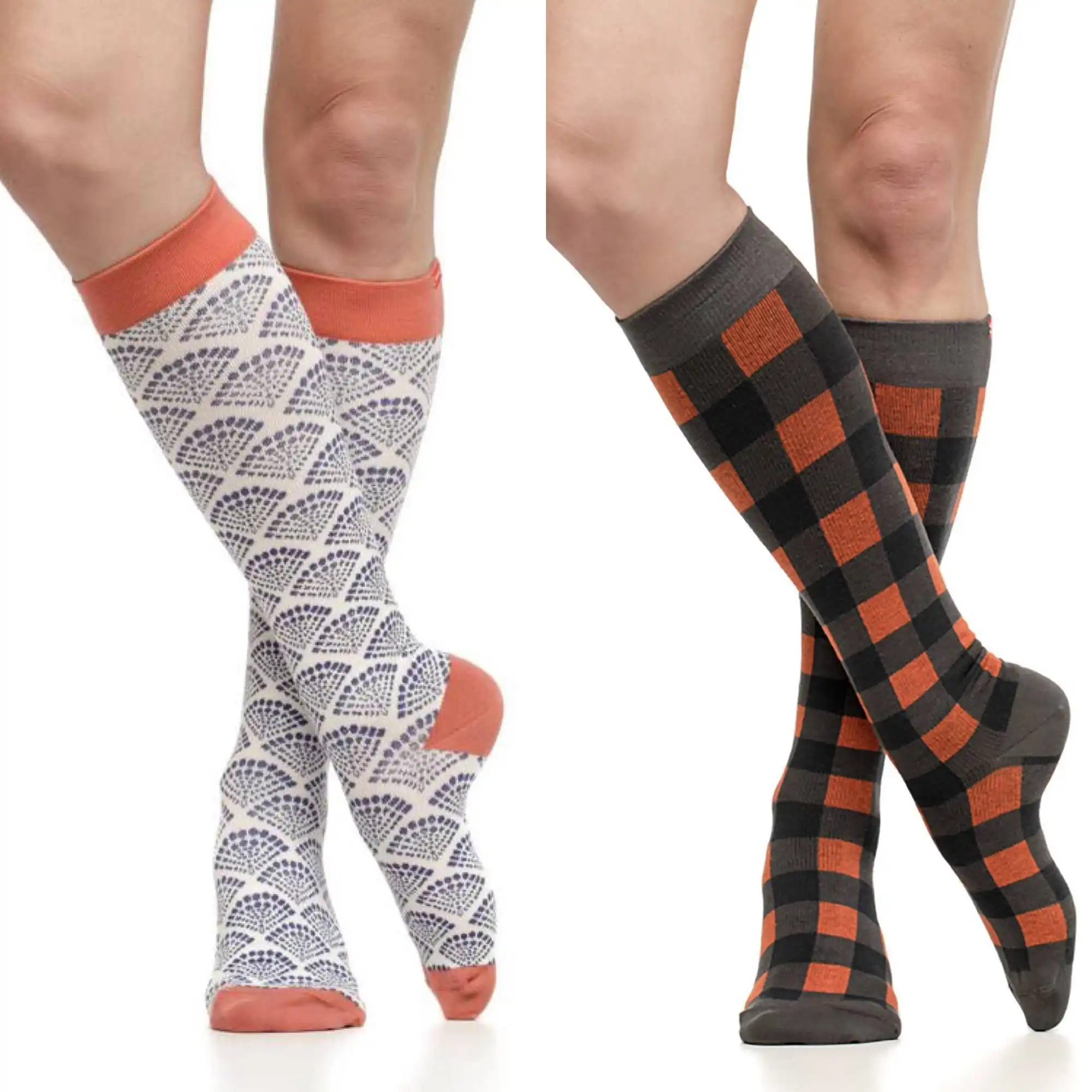
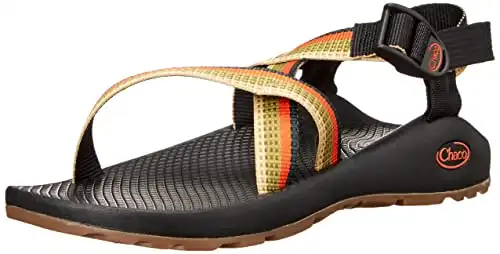
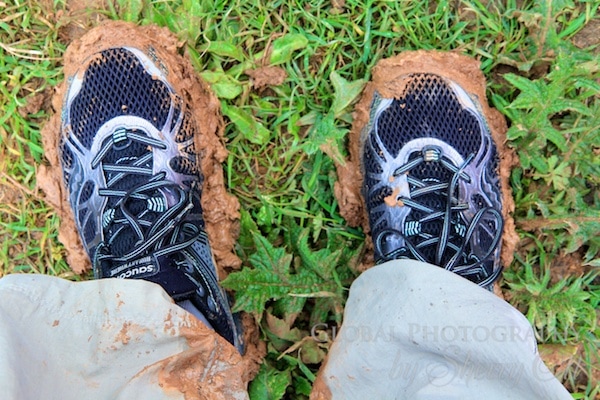
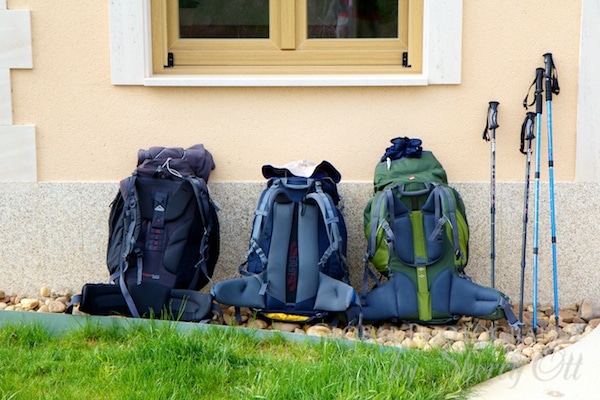
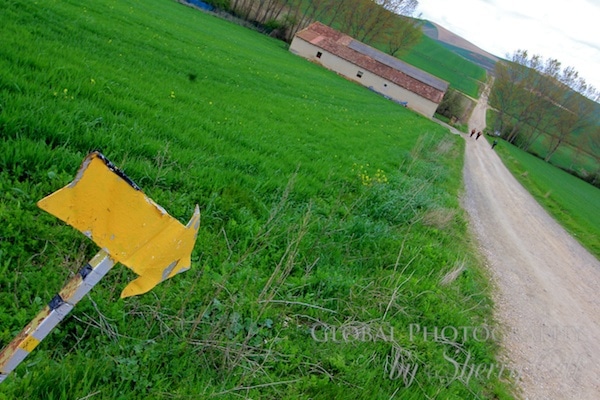
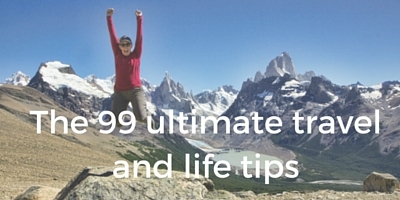
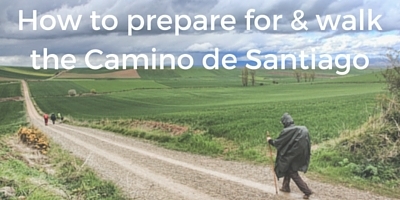
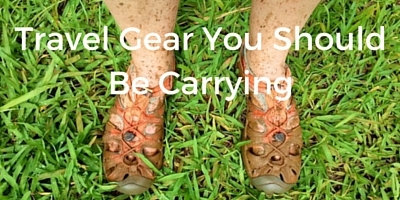
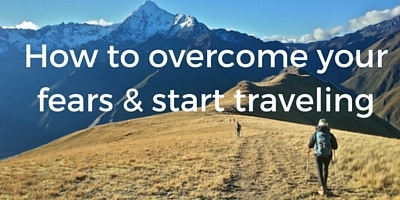
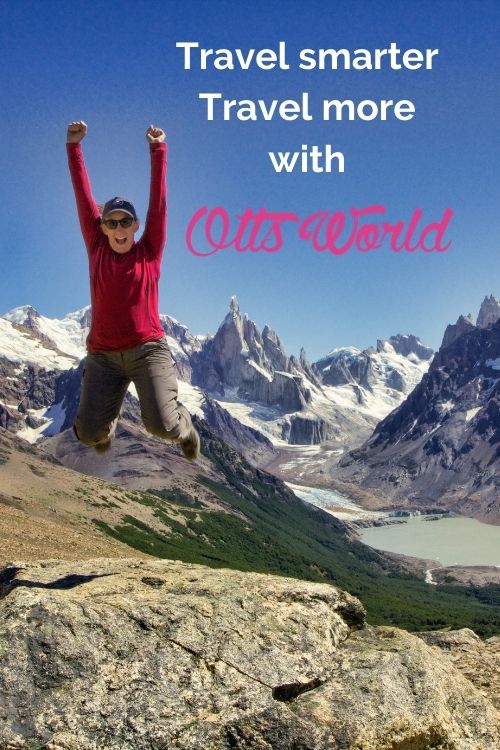
By Barbara Weibel June 12, 2012 - 7:48 am
Hey Sherrie: You know how you can tell when someone from the U.S.has been on the road a loooooong time? When we start to call sweaters jumpers or pullovers 🙂
By Brian Setzer June 12, 2012 - 8:42 am
I would add something in about preparing for siesta time and that almost nothing is open on Sundays. Sometimes you will come across a store to get food, but often not. It’s best to actually get what you want for lunch before 12:00 and buy for Sunday on Saturday. None of the stores post hours and even most of the grocery stores close in the afternoon for a few hours.
By Sherry June 12, 2012 - 10:41 am
Hey Brian – I don’t know if it was the economic woes or what – but I was all braced for things being closed on Sundays – but I never ran into that problem once in the 5 weeks. Even little villages had one or two stores or a bar open on Sundays. I’m not sure what’s going on…maybe they realized they needed the money! However – you do make a good point – I always had something just in case things were closed…as the moment you start depending on something being open it won’t be!
By Candace Rose Rardon June 12, 2012 - 10:21 am
Fantastic round-up, Sherry – wish I’d had this before I set out on the Camino 🙂 I agree with you about theft – I definitely worried a lot less about it than I expected to. I brought a bicycle lock with me to keep my backpack safe, but ended up only using it a few times in bigger albergues. I’m so glad you had a great time!
By Linda June 12, 2012 - 1:13 pm
I’m curious about the SIM card you bought. I live in Spain, so I have my opinions about different companies, but just wondering which one you found had the best offer and how reliable the connection was, please?
Oh, and I enjoyed following your journey so much, thanks for sharing it!
By Sherry June 12, 2012 - 4:24 pm
Hi LInda, thanks for following my camino journey! I used a sim card from Vodaphone and it worked the majority of the time on the trail. Hope that helps!
By Kristin June 12, 2012 - 1:24 pm
Excellent run-down of the trail!
By lara dunston June 13, 2012 - 5:17 am
Wow. What comprehensive advice. Great stuff!
By Jarmo June 13, 2012 - 7:09 am
Great advice Sherry. Reading your articles about the camino, have definitely gotten me more and more interested in the hike. I did not know you could get your pack shipped along the route, but it does make sense.
By Jonathan Look, Jr. June 13, 2012 - 4:47 pm
I had never heard of this until I saw the movie “The Way”. Looks like an amazing trip. Maybe next year!
By Will Peach June 13, 2012 - 5:45 pm
Neat little write-up Sherry. My mother wouldn’t be best please if I dragged in shoes as muddy as those. I do hope you managed to hose them down.
By Mark H June 16, 2012 - 1:58 am
Very comprehensive writeup. I am so keen to make this journey and your writing makes it more and more mouthwatering. It is still a few years away for me however.
By Drew Meyers July 21, 2012 - 6:34 am
One of my best friends did this this year for a few days and loved it. It’s certainly classified as a must do at some point in my life. Just not sure when it’ll happen at this stage, but it’s only a matter of time 🙂
By Tom July 30, 2012 - 7:12 pm
I walked the full Camino May/June 2012. I disagree strongly with the shoe advice. It rains and the trail gets slippery. There are baseball sized rocks on steep narrow slopes, dangerous in any weather. Tennis type shoes led to slips and ankle twists. When wet they promote blisters and infection. There were a number of folks mostly younger, visiting doctors because of nonsupporting and/or wet footwear. Get ankle supporting, waterproof (Goretex or similar) footwear. It will save you pain and grief.
By Sherry August 2, 2012 - 9:57 am
Thanks for your input Tom. I actually walked the whole way in trail running shoes and through the rain and mud – and I survived. But it’s a personal choice for everyone. I couldn’t afford to have the extra weight for the remainder of my travels in Europe – so I did the trail shoes. And I feel like people get inured and have foot problems for many different reasons…it’s not only because of shoes. The main thing is to test it out before hand the best you can and know that if you have to change your mind even after you start walking – you can. There are plenty of places that sell various types of shoes along the way!
By Jon Pitts August 2, 2013 - 4:39 pm
I also would recommend hiking boots rather than trainers, especially if you are carrying your own pack. I would also disagree that the Camino is not physically demanding. It can be quite demanding, as it was for me and my experienced hiker friends. It’s always best to overprepare.
By Sherry August 2, 2013 - 4:58 pm
Thanks for your input Jon! Hiking boots vs trail running shoes (more stabile and durable than regular trainers) are personal preference – I survived with mine – but that’s becuase it was all I had at the time and I wanted to stay light 80% of the time they worked great for me. Yes – I agree – the hike is demanding in many ways – mentally AND physically. In my head I just categorize it as more of a long distance hiking challenge rather than a pure hiking/scrambling/navigating challenge. Obviously everyone will look at it differently based on their personal experiences – but thanks for providing your feedback as it will be helpful to others reading this!
By John Williams August 3, 2012 - 4:25 pm
Information packed post. There is a variant of the Camino starting in Brussels and I come across other variants while hiking in Belgium. I’m always tempted to keep walking whenever I’m on the trail.
Can you give me more details on the Spanish SIM card for 3G? How much does it cost for 100mb data?
By Sherry August 27, 2012 - 10:35 am
I got the initial data plan for about $50 and that data lasted me the entire time. However I had to continue to top up my account each week so that I could still use my cell phone. All in all – I probably spent about $110 for my 5 weeks of connectivity. However I’m sure that with a little more research you can probably do this cheaper. I initially had someone get me the original sim – and I think if I had been aware of the various plans and how it worked – I might have chose differently – but I had to work with what I was given. Just make a stop in at Vodafone – and tell them what you are trying to do and for how long and I’m sure they can provide you with various options. It was totally worth it for me to stay connected and blog the entire way.
By Avriane August 27, 2012 - 7:52 am
I have to decide between taking a smallish pocket type camera and a good one. Worthwhile carrying the extra weight of a good camera or not?
By Sherry August 27, 2012 - 10:32 am
It’s a very personal decision for each person. For me, because photography is my love and I wanted to have the ability to manipulate and control my exposures manually – I chose to take my photography equipment (SLR and lenses). If you don’t know how to use your SLR manually- then I would say don’t bother as if you are going to shoot auto anyway – then just take a smaller camera. The small cameras are very good for quality of photos. For me however- it was absolutely worth the extra weight.
By Tom @ Waegook Tom December 29, 2012 - 2:32 am
Great post! I’ve always wondered about doing the trail, but I’ve never been a serious hiker (however I do enjoy walking) – good to see that it’s not that strenuous! This is super useful Sherry, so thanks for sharing 🙂
By Nida January 23, 2013 - 5:07 pm
Those shoes look like they’ve seen better days. Thanks for the detailed post. It was fun to read.
By John David February 27, 2013 - 3:29 pm
My son, a good friend, and myself are heading to the Camino 5/13. I’m finding it difficult to decide on how we are going to get to St. Jean Pied De Port and how we are going to get home. I’ve read that most travelers from the US fly into Paris and take the train but that seems out of the way since we have to make it back to Paris to fly home. Have any advice? Thank you in advance! 🙂
By Sherry February 28, 2013 - 12:21 pm
Hi John – how exciting that you are doing the Camino with your son! I wish I could have taken my dad with me. Unfortunately I did not actually start in SJPDP – I started in Pamplona as it was easier to get to and I had a limited time of when I had to finish…so I cut 3 days off the beginning. HOwever I had heard of people taking the train from Barcelona as far as they could go and then doing a taxi or car or bus the rest of the way. Have you checked out the forums – they normally have great advice there. Also – tomorrow actually I’m heading to a friend’s place whom I met along the trail to see him again and I know he started there so I will ask him and see how he did it and get back to you if it’s useful!
By John David March 1, 2013 - 9:44 am
Thank you! 😉 I’ve been checking the forums and most fly into Paris or Madrid, there is a connecting flight into Pamplona and I’m not sure why most hikers don’t take advantage of that? Happy trails!
By Sherry March 1, 2013 - 7:03 pm
My friend suggested to fly to Madrid and take the bus directly there. Check to see if that’s possible as he said there was a direct bus!
By John David March 1, 2013 - 8:27 pm
Thank you both.
By Catherine Clarke June 20, 2013 - 7:14 pm
Everything is booked for our trip at the end of July 2013. I’m going with my daughter. Thanks for the info on the phones – that clears up one question. The other I had was about the availability of ATMs. I’m guessing in the larger cities this is not a big deal, but I need a comfort level on this subject.
Thanks,
By Sherry June 20, 2013 - 9:29 pm
I never had an issue with finding an ATM. The bigger villages def. had them and just get enough to last you about 3 or 4 days at a time and you’ll be fine. Let me know how it goes! I’d love to be on the Camino about now!
By Stephen Whaley August 5, 2013 - 8:40 am
Enjoyed your thoughts! I will be biking the camino from SJPP because I have a prosthetic leg. I have read that some albeurges only take walkers. Did you note if there was a difficulty in storing cycles? How were cyclists received by other pilgrims?
By Sherry August 5, 2013 - 12:47 pm
I didn’t notice any difficulty with people storing bikes – but I can’t say for sure. As far as how they were received by other pilgrims – it’s a really different feel since bikers are just a flash in the ‘life of a walking pilgrim’ – so they are welcomed – but it’s next to impossible to form the types of friendships and commradery that you get when you are all sort of going the same pace. I think that’s just the reality of the pace of travel. Best of luck! Let me know how it goes!!
By Nev November 16, 2013 - 6:08 pm
Very informative and well-written!
Buen Camino!
Nev 🙂
By kalavati December 24, 2013 - 11:09 am
Thank you so much for this!! I had a “Knowingness” to do this walk. So spring or fall, I’ll see.
Incredible photo journey! WOW!!!
By Sherry December 26, 2013 - 10:16 am
I hope you make it there to do the hike – it’s a great experience. I hope to do another route again one day!
By kristen nealon January 17, 2014 - 1:59 pm
Planning on future trip with my husband. How do we plan,how long does it take, what time of year should we go, and what is the cost?…help
By Sherry January 18, 2014 - 8:46 am
Those are some meaty questions – I can give you some quick answers – but I suggest that you read my other posts too for some more info. Time of year – I suggest spring or fall – the trail isn’t as busy. Not a lot of planning is needed honestly – you don’t have to book a thing in advance – you just start walking. If you go in the spring or fall – you’ll always find a place to sleep at a albergue – it is simple lodging – but no reservations are really required. How long it takes depends on where you start – if you start at the beginning of the Way of St. James trail – then it will take about 5 weeks. I started in Pamplona because it was easier for me to get to and it also took about 5 weeks – but that’s becuase I took a rest day every week. The cost can be very cheap is you stay in albergues (about $10 to 12 Euro a night for a simple bunkbed). Food is also cheap in the villages. You could probably plan for $30 US a day if you were ok with staying in albergues.
By Shirley January 19, 2014 - 3:27 am
Sherry I want to do the camino as a solo female. I would like to have some aspects of it planned mostly to alleviate my worried mind(but most of all my worrying family). I am wondering how your experience was with Rayo travel was. Also if you were staying at an accommodation that was booked with rayo would you still have the bag transfer option available?
By Sherry January 22, 2014 - 1:13 am
The bag transfer is available to anyone doing any style of travel. It’s a separate company. Regarding Rayo – I didn’t use them to book accommodations really – I simply used their phone app which helped me easily make lodging arrangements while hiking. My experience with them though was very good for what I utilized them for. Not sure if that answers your question or not?
By John WHITELAW January 27, 2015 - 5:14 am
My friend and I are doing the 200 miles from LEON from the first of June. We are from Scotland. Are horsefly, mosquitoes, or our equivalent the dreaded midgie, a problem on that part at that time of the year? Cheers.
By Sherry January 28, 2015 - 11:13 am
I walked the trail in April/May and didn’t have any trouble with any bugs. But I honestly don’t know what it will be like in June when it’s warmer. Best of luck on your hike though! Bring bug spray in case!
By Nan March 29, 2015 - 2:33 pm
Sherry,
I know you’re not religious and do refer people to the Camino forums but if someone is making a religious pilgrimage they need to have the Camino Credential, which must be stamped each day; twice a day is recommended for the last 100km for walkers or horsebackriders and 200km for bicyclers. If they take a bus, taxi or some other mode of trasportation, they won’t qualify for the Compostela, the document certifying they have completed the pilgrimage.
By Sherry April 1, 2015 - 1:40 am
I actually did get my Compostela. It’s very simple to get a stamp every day at the alberges or hotels. Plus – it’s fun to fill up your Pilgrim passport!
By Vicki Ward November 7, 2015 - 7:24 pm
I’d like to recommend another company, Nativa Travel, a company based in Spain that has over a decade of experience on the Camino. They can plan your trip anyway you like and they also have amazing guides. I have personal experience with them and have traveled many of the Caminos, multiple times on my own or with their help. Amazing people, really!
By Don Bloom December 29, 2015 - 3:53 pm
Thanks for the very helpful information. One question I have – how do you pay for accommodations? Are credit cards commonly accepted? Or is paying with cash the rule?
By Sherry December 31, 2015 - 3:48 pm
I normally just paid with cash. The Albergues are cheap – so it’s not like you need to carry a bunch of cash. Plus – most towns have an ATM normally – so I would just get a supply of cash when I needed it. Hope that helps!
By Annette Weis April 10, 2016 - 7:45 am
Is the trail a one-way trek? How do you get out of the last town? Or do you walk all the way back to Pamplona and catch a flight from there back to Paris or Madrid?
By Sherry April 10, 2016 - 3:31 pm
Yes – it’s a one way trek for 99% of the people. In Santiago – you celebrate, get your compostella, and then fly out from the airport there. I flew from Santiago to Barcelona. Santiago is well connected via rail, bus, and plane – so you have lots of options!
By Epimaco Roca June 6, 2016 - 11:03 am
Great blog about the Camino, Sherry! It is very helpful. I hope to do this someday soon, God willing.
By Philip Nelson June 6, 2016 - 5:35 pm
When did you go in April/May Sherry? My wife and I (both 67) will go next year and have a lot of flexibility. I want to be able to take our time and enjoy it and not have to race to the next Albergue to get a bed but would of course love to have a bit warmer weather. Seeing the spring flowers is also very important to us. So any recommendations would be great, early, mid, late April. We figure 5 weeks. Thanks.
By Sherry June 6, 2016 - 6:36 pm
I started the last week of April and finished at the end of May – it took me 5 weeks and I took a one rest day every week. It was a great time to go – however you will run into rain occasionally of course. But there are fewer people and no reservations required. At least that’s how it was 4 yrs ago when I did it!
By Philip Nelson June 6, 2016 - 7:36 pm
Thanks Sherry. Kind of what I was thinking and what we will do! Can’t wait!
By Patti Kennedy June 14, 2016 - 10:15 pm
Thank you for sharing your pilgrimage, my husband and I will be starting our pilgrimage, 500k in the spring 2017. We are excited and are preparing ourselves body, mind and spirit. We both turn 69 late summer and this is a wonderful adventure to look forward to. Your blog was helpful information about the reality that rain and mud will be accompanying us but the breath of Spring will lead the way.
By Emily August 16, 2016 - 9:33 am
Hi Sherry – Thanks so much for some great, detailed info. I am starting an RTW trip (April 2018) as a solo female with the Camino first (before I head over to the Eastern Europ/Caucasus). Is it easy to hop over to Portugal via rail upon finishing Camino? Going there for some r and R first! Love your blog. Thanks!
By Sherry August 16, 2016 - 5:43 pm
Emily – congrats your upcoming trip and adventure – sounds amazing! And it will be great to start with the Camino. As for getting to Portugal from Santiago – I’m not really sure. I stayed in Spain after I finished – so I don’t know if there are rail options of not. I would guess there are easy ways to get to portugal from there though as it’s a big city and Portugal isn’t far away! Sorry I’m not of more help.
By Emily August 17, 2016 - 9:22 am
Sherry – Thanks. It is super close, so I am sure I will figure it out. Thanks for the encouragement. I think the hardest part is being patient until I head out next year. Please keep up all of the great writing and sharing. You have no idea how inspiring it is – keeps me going and committed to my goal in the day-to-day. Have a great week.
By Wilma October 28, 2016 - 3:30 pm
Emily you can very easily plan a trip by bus, train, plain or whatever on http://www.rome2rio.com I wish you good luck on the Camino. My best friend and I are goìng to walk the Camino starting mid-april 2018 (that’s our planning right now anyway) so perhaps we see each other somewhere around….
By Emily October 31, 2016 - 9:21 am
Wilma – great site! Thank you so much for the tip. I do think it will be easy to get to Portugal when I finish. Best of luck on your travels, as well!
By Barbara November 3, 2016 - 3:50 pm
Agree with most. Comprehensive and practical. But i wore lightweight goretex boots and used lightweight foldable poles and the Camino became an enjoyable hike. Both were essential for my comfort and to maximise my total ability to walk. My arms propelled me. Great.
By Petra March 13, 2017 - 5:17 am
Hi Emily and Wilma and Sherry
First of all, thank you Sherry for this inspiring and comprehensive post. I too am planning to go in 2018, also as a solo female, as part of a 12 month career-break. After reading these post, I’m thinking of doing the trail in April-May. Who knows, perhaps we’ll meet up?!
Sherry – I like that you can send your luggage on. What size was your day pack, Sherry? What weight did you carry?
By Sherry March 13, 2017 - 4:13 pm
I’m not sure how big my pack was – it was a medium sized day pack from REI. Probably around 40 L pack. And I carried probably about 15 lbs in it. That includes my camera gear and lenses.
Have a wonderful hike! You will love it!!
By colin feekery April 14, 2017 - 8:20 pm
Sherry – I only have 6 days – and this would be my first Camino – which part would you recommend? I intend to walk on my own and reflect. I will be between business appointments dropping in from Australia on my way to London.
By Sherry April 15, 2017 - 1:31 pm
Hmmm – that’s a hard one. I really enjoyed my days hiking out of Pamplona and I liked it around Astorga. The only part I would tell you to avoid is the last 100 km around Sarria – there are so many people who start there that it makes the trail more crowded and less enjoyable. Earlier on in the trail is much less crowded. Just pick a place that you can get to easily via public transportation – and start there. That normally means one of the bigger cities along the way to start from.
By Sharlet June 14, 2017 - 11:29 pm
Thank you for the info! So helpful. Leaving in August solo and trying to gather all the information I can. I only have six weeks, so I may take a bus or taxi part of the journey. What areas would you suggest riding?
At 65, I will be a slow stroller on the Camino.
By Sherry June 16, 2017 - 10:56 am
I didn’t skip any of the areas…but certainly around the bigger cities are the less scenic stuff. I enjoyed the contrast – but many people didn’t like the bigger city walking as there’s more traffic or course and sometimes you are walking past airports,on highways, etc. So I would just look at the map and mark the bigger cities as the potential areas to use a bus/taxi! Good luck – you will do GREAT!!! Let me know how it goes!
By Katie Kitty August 28, 2018 - 7:06 pm
Hi Sherry,
I am wondering about showers at the Alburgues. Are they coed? Is their privacy? If so, to what degree? Open showers? Flimsy shower curtain? Are showers timed? Please describe the typical showers/bathrooms.
Thank you for all the great information. Looking forward to hearing from you
Katie Kitty
By Sherry August 29, 2018 - 12:30 am
IT’s been a few years – but as I recall most of the places had bathrooms for men and women. The women’s showers normally were not times and yes there was normally a curtain. I can’t remember how flimsy they were. However I don’t recall being shocked or anything. It was sort of like a women’s lockeroom from what I recall!